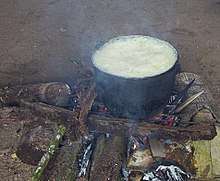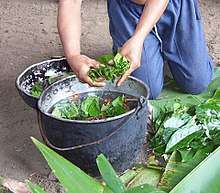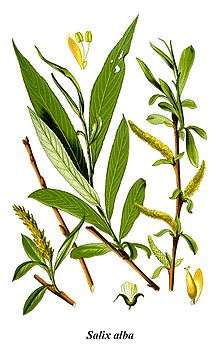Ayahuasca
Ayahuasca[note 1] is a South American entheogenic brew commonly made out of the Banisteriopsis caapi vine, the Psychotria viridis shrub or a substitute, and possibly other ingredients;[1] although, in the West, a chemically similar preparation also known and sold as ayahuasca, but occasionally also known as "pharmahuasca", can be prepared using illicitly manufactured N,N-dimethyltryptamine (DMT) and a pharmaceutical monoamine oxidase inhibitor (MAOI) such as isocarboxazid.[2][3] The brew is used as a traditional spiritual medicine in ceremonies among the indigenous peoples of the Amazon basin.[4]
B. caapi contains several alkaloids that act as MAOIs, which are required for DMT to be orally active.[5] The other required ingredient is a plant that contains the primary psychoactive, DMT. This is usually the shrub P. viridis,[5] but Diplopterys cabrerana may be used as a substitute.[6][7] Other plant ingredients often or occasionally used in the production of ayahuasca include Justicia pectoralis,[8] one of the Brugmansia (especially Brugmansia insignis and Brugmansia versicolor, or a hybrid breed) or Datura species,[9] and mapacho (Nicotiana rustica).[10]
Nomenclature
Ayahuasca is known by many names throughout Northern South America and Brazil.
Ayahuasca is the hispanicized (traditional) spelling of a word in the Quechuan languages, which are spoken in the Andean states of Ecuador, Bolivia, Peru, and Colombia—speakers of Quechuan languages who use the modern Alvarado orthography spell it ayawaska.[11] This word refers both to the liana Banisteriopsis caapi, and to the brew prepared from it. In the Quechua languages, aya means "spirit, soul", or "corpse, dead body", and waska means "rope" or "woody vine", "liana".[12] The word ayahuasca has been variously translated as "liana of the soul", "liana of the dead", and "spirit liana".[13]
In Brazil, the brew and the liana are informally called either caapi or cipó; the latter is the Portuguese word for liana (or woody climbing vine). In the União do Vegetal of Brazil, an organised spiritual tradition in which people drink ayahuasca, the brew is prepared exclusively from B. caapi and Psychotria viridis. Adherents of União do Vegetal call this brew hoasca or vegetal; Brazilian Yawanawa call the brew "uní".[14]
The Achuar people[15] and Shuar people[16] of Ecuador and Peru call it natem, while the Sharanahua peoples of Peru call it shori.[17]
History
Evidence of ayahuasca use dates to at least 1000 A.D., such as a bundle containing the residue of ayahuasca ingredients and various other preserved shamanic substances in a cave in southwestern Bolivia, discovered in 2010.[18][19]
In the 16th century, Christian missionaries from Spain first encountered indigenous western Amazonian basin South Americans (modern Peru/Ecuador) using ayahuasca; their earliest reports described it as "the work of the devil".[20] In the 20th century, the active chemical constituent of B. caapi was named telepathine, but it was found to be identical to a chemical already isolated from Peganum harmala and was given the name harmine. Beat writer William S. Burroughs read a paper by Richard Evans Schultes on the subject and while traveling through South America in the early 1950s sought out ayahuasca in the hopes that it could relieve or cure opiate addiction (see The Yage Letters). Ayahuasca became more widely known when the McKenna brothers published their experience in the Amazon in True Hallucinations. Dennis McKenna later studied pharmacology, botany, and chemistry of ayahuasca and oo-koo-he, which became the subject of his master's thesis.
Richard Evans Schultes allowed Claudio Naranjo to make a special journey by canoe up the Amazon River to study ayahuasca with the South American Indians. He brought back samples of the beverage and published the first scientific description of the effects of its active alkaloids.[21]
In Brazil, a number of modern religious movements based on the use of ayahuasca have emerged, the most famous being Santo Daime and the União do Vegetal (or UDV), usually in an animistic context that may be shamanistic or, more often (as with Santo Daime and the UDV), integrated with Christianity. Both Santo Daime and União do Vegetal now have members and churches throughout the world. Similarly, the US and Europe have started to see new religious groups develop in relation to increased ayahuasca use.[22] Some Westerners have teamed up with shamans in the Amazon forest regions, forming ayahuasca healing retreats that claim to be able to cure mental and physical illness and allow communication with the spirit world.
In recent years, the brew has been popularized by Wade Davis (One River), English novelist Martin Goodman in I Was Carlos Castaneda,[23] Chilean novelist Isabel Allende,[24] writer Kira Salak,[25][26] author Jeremy Narby (The Cosmic Serpent), author Jay Griffiths ("Wild: An Elemental Journey"), American novelist Steven Peck, radio personality Robin Quivers,[27] and writer Paul Theroux (Figures in a Landscape: People and Places).[28]
Preparation
Sections of Banisteriopsis caapi vine are macerated and boiled alone or with leaves from any of a number of other plants, including Psychotria viridis (chacruna), Diplopterys cabrerana (also known as chaliponga and chacropanga),[29] and Mimosa tenuiflora, among other ingredients which can vary greatly from one shaman to the next. The resulting brew may contain the powerful psychedelic drug DMT and MAO inhibiting harmala alkaloids, which are necessary to make the DMT orally active. The traditional making of ayahuasca follows a ritual process that requires the user to pick the lower Chacruna leaf at sunrise, then say a prayer. The vine must be "cleaned meticulously with wooden spoons"[30] and pounded "with wooden mallets until it's fibre."[30]
Brews can also be made with plants that do not contain DMT, Psychotria viridis being replaced by plants such as Justicia pectoralis, Brugmansia, or sacred tobacco, also known as mapacho (Nicotiana rustica), or sometimes left out with no replacement. This brew varies radically from one batch to the next, both in potency and psychoactive effect, based mainly on the skill of the shaman or brewer, as well as other admixtures sometimes added and the intent of the ceremony. Natural variations in plant alkaloid content and profiles also affect the final concentration of alkaloids in the brew, and the physical act of cooking may also serve to modify the alkaloid profile of harmala alkaloids.[31][32]
The actual preparation of the brew takes several hours, often taking place over the course of more than one day. After adding the plant material, each separately at this stage, to a large pot of water it is boiled until the water is reduced by half in volume. The individual brews are then added together and brewed until reduced significantly. This combined brew is what is taken by participants in ayahuasca ceremonies.
Traditional use
Ayahuasca is used largely as a treasured aid to spiritual practice. People who work with ayahuasca in non-traditional contexts often align themselves with the philosophies and cosmologies associated with ayahuasca shamanism, as practiced among indigenous peoples like the Urarina of the Peruvian Amazon.[33] While non-native users know of the spiritual applications of ayahuasca, a less well-known traditional usage focuses on the medicinal properties of ayahuasca. When used for its medicinal purposes, ayahuasca affects the human consciousness for less than six hours, beginning half an hour after consumption and peaking after two hours. In some cases, individuals experience significant psychological stress during the experience. Ayahuasca also has cardiovascular effects, moderately increasing heart rate and diastolic blood pressure. It is for this reason that extreme caution should be taken with those who may be at risk of heart disease.[34]
The psychedelic effects of ayahuasca include visual and auditory stimulation, the mixing of sensory modalities, and psychological introspection that may lead to great elation, fear, or illumination. It may induce intense vomiting and occasional diarrhea.[35] These purgative properties are known as la purga or "the purge".
Dietary taboos are often associated with the use of ayahuasca.[36] In the rainforest, these tend towards the purification of one's self – abstaining from spicy and heavily seasoned foods, excess fat, salt, caffeine, acidic foods (such as citrus) and sex before, after, or during a ceremony. A diet low in foods containing tyramine has been recommended, as the speculative interaction of tyramine and MAOIs could lead to a hypertensive crisis; however, evidence indicates that harmala alkaloids act only on MAO-A, in a reversible way similar to moclobemide (an antidepressant that does not require dietary restrictions). Dietary restrictions are not used by the highly urban Brazilian ayahuasca church União do Vegetal, suggesting the risk is much lower than perceived and probably non-existent.[36]
Ceremony and the role of shamans
Shamans and experienced users of ayahuasca advise against consuming ayahuasca when not in the presence of one or several well-trained shamans.[37]
In some areas, there are purported brujos (Spanish for "witches") who masquerade as real shamans and who entice tourists to drink ayahuasca in their presence. Shamans believe one of the purposes for this is to steal one's energy and/or power, of which they believe every person has a limited stockpile.[37]
The shamans lead the ceremonial consumption of the ayahuasca beverage,[38] in a rite that typically takes place over the entire night. During the ceremony, the effect of the drink lasts for hours. Prior to the ceremony, participants are instructed to abstain from spicy foods, red meat and sex.[39] The ceremony is usually accompanied with purging which include vomiting and diarrhea, which is believed to release built up emotions and negative energy.[40]
Traditional brew
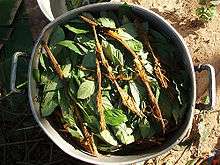
Traditional ayahuasca brews are usually made with Banisteriopsis caapi as an MAOI, while dimethyltryptamine sources and other admixtures vary from region to region. There are several varieties of caapi, often known as different "colors", with varying effects, potencies, and uses.
DMT admixtures:
- Psychotria viridis (Chacruna)[10] – leaves
- Diplopterys cabrerana (Chaliponga, Chagropanga, Banisteriopsis rusbyana)[10] – leaves
- Psychotria carthagenensis (Amyruca)[10] – leaves
- Mimosa tenuiflora (M. hostilis) - Root bark
Other common admixtures:
- Justicia pectoralis[8]
- Brugmansia (Toé)[10]
- Nicotiana rustica[10] (Mapacho, variety of tobacco)
- Ilex guayusa,[10] a relative of yerba mate
Common admixtures with their associated ceremonial values and spirits:
- Ayahuma[10] bark: Dead head tree. Provides protection and is used in healing susto (soul loss from spiritual fright or trauma).
- Capirona[10] bark: Provides cleansing and protection. It is noted for its smooth bark, white flowers, and hard wood.
- Chullachaki caspi[10] bark (Brysonima christianeae): Provides cleansing to the physical body. Used to transcend physical body ailments.
- Lopuna blanca bark: Provides protection.
- Punga amarilla bark: Yellow Punga. Provides protection. Used to pull or draw out negative spirits or energies.
- Remo caspi[10] bark: Oar Tree. Used to move dense or dark energies.
- Wyra (huaira) caspi[10] bark (Cedrelinga catanaeformis): Air Tree. Used to create purging, transcend gastro/intestinal ailments, calm the mind, and bring tranquility.
- Shiwawaku bark: Brings purple medicine to the ceremony.
- Uchu sanango: Head of the sanango plants.
- Huacapurana: Giant tree of the Amazon with very hard bark.
Non-traditional usage
In the late 20th century, the practice of ayahuasca drinking began spreading to Europe, North America and elsewhere.[41] The first ayahuasca churches, affiliated with the Brazilian Santo Daime, were established in the Netherlands. A legal case was filed against two of the Church's leaders, Hans Bogers (one of the original founders of the Dutch Santo Daime community) and Geraldine Fijneman (the head of the Amsterdam Santo Daime community). Bogers and Fijneman were charged with distributing a controlled substance (DMT); however, the prosecution was unable to prove that the use of ayahuasca by members of the Santo Daime constituted a sufficient threat to public health and order such that it warranted denying their rights to religious freedom under ECHR Article 9. The 2001 verdict of the Amsterdam district court is an important precedent. Since then groups that are not affiliated to the Santo Daime have used ayahuasca, and a number of different "styles" have been developed, including non-religious approaches.[42]
Ayahuasca analogs
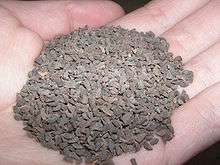
In modern Europe and North America, ayahuasca analogs are often prepared using non-traditional plants which contain the same alkaloids. For example, seeds of the Syrian rue plant can be used as a substitute for the ayahuasca vine, and the DMT-rich Mimosa hostilis is used in place of chacruna. Australia has several indigenous plants which are popular among modern ayahuasqueros there, such as various DMT-rich species of Acacia.
The name "ayahuasca" specifically refers to a botanical decoction that contains Banisteriopsis caapi. A synthetic version, known as pharmahuasca, is a combination of an appropriate MAOI and typically DMT. In this usage, the DMT is generally considered the main psychoactive active ingredient, while the MAOI merely preserves the psychoactivity of orally ingested DMT, which would otherwise be destroyed in the gut before it could be absorbed in the body. In contrast, traditionally among Amazonian tribes, the B. Caapi vine is considered to be the "spirit" of ayahuasca, the gatekeeper, and guide to the otherworldly realms.[43]
Brews similar to ayahuasca may be prepared using several plants not traditionally used in South America:
DMT admixtures:
- Acacia maidenii (Maiden's wattle) – bark *not all plants are "active strains", meaning some plants will have very little DMT and others larger amounts
- Acacia phlebophylla, and other Acacias, most commonly employed in Australia – bark
- Anadenanthera peregrina, A. colubrina, A. excelsa, A. macrocarpa
- Desmanthus illinoensis (Illinois bundleflower) – root bark is mixed with a native source of beta-Carbolines (e.g., passion flower in North America) to produce a hallucinogenic drink called prairiehuasca.[44]
MAOI admixtures:
- Harmal (Peganum harmala, Syrian rue) – seeds
- Passion flower[45]
- synthetic MAOIs, especially RIMAs
Effects
People who have consumed ayahuasca report having mystical or religious experiences and spiritual revelations regarding their purpose on earth, the true nature of the universe, and deep insight into how to be the best person they possibly can.[46] This is viewed by many as a spiritual awakening and what is often described as a rebirth.[37]:67–70 It is often reported that individuals feel they gain access to higher spiritual dimensions and make contact with various spiritual or extra-dimensional beings who can act as guides or healers.[47]
Recently, ayahuasca has been found to interact specifically with the visual cortex of the brain. In one study, de Araujo et al. measured the activity in the visual cortex when they showed participants photographs. Then, they measured the activity when the individuals closed their eyes. In the control group, the cortex was activated when looking at the photos, and less active when the participant closed his eyes; however, under the influence of ayahuasca and DMT, even with closed eyes, the cortex was just as active as when looking at the photographs. This study suggests that ayahuasca activates a complicated network of vision and memory which heightens the internal reality of the participants.[48]
It is claimed that people may experience profound positive life changes subsequent to consuming ayahuasca, by author Don Jose Campos[37]:25–28 and others.[49]
Vomiting can follow ayahuasca ingestion; this is considered by many shamans and experienced users of ayahuasca to be a purging and an essential part of the experience, representing the release of negative energy and emotions built up over the course of one's life.[37]:81–85 Others report purging in the form of diarrhea and hot/cold flushes.
The ingestion of ayahuasca can also cause significant but temporary emotional and psychological distress. Excessive use could possibly lead to serotonin syndrome (although serotonin syndrome has never been specifically caused by ayahuasca except in conjunction with certain anti-depressants like SSRIs). Depending on dosage, the temporary non-entheogenic effects of ayahuasca can include tremors, nausea, vomiting, diarrhea, autonomic instability, hyperthermia, sweating, motor function impairment, sedation, relaxation, vertigo, dizziness, and muscle spasms which are primarily caused by the harmala alkaloids in ayahuasca. Long-term negative effects are not known.[50][51]
A few deaths linked to participation in the consumption of ayahuasca have been reported.[52][53][54][55] Some of the deaths may have been due to unscreened preexisting heart conditions, interaction with drugs, such as antidepressants, recreational drugs, caffeine (due to the CYP1A2 inhibition of the harmala alkaloids), nicotine (from drinking tobacco tea for purging/cleansing), or from improper/irresponsible use due to behavioral risks or possible drug to drug interactions.[50][56]
Potential therapeutic effects
There are potential antidepressant and anxiolytic effects of ayahuasca.[57][58][59][60][61] For example, in 2018 it was reported that a single dose of ayahuasca significantly reduced symptoms of treatment-resistant depression in a small placebo-controlled trial.[62] More specifically, statistically significant reductions of up to 82% in depressive scores were observed between baseline and 1, 7, and 21 days after ayahuasca administration, as measured on the Hamilton Rating Scale for Depression (HAM-D), the Montgomery-Åsberg Depression Rating Scale (MADRS), and the Anxious-Depression subscale of the Brief Psychiatric Rating Scale (BPRS).[63]
Chemistry and pharmacology
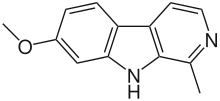
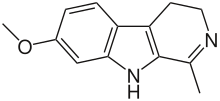

Harmala alkaloids are MAO-inhibiting beta-carbolines. The three most studied harmala alkaloids in the B. caapi vine are harmine, harmaline and tetrahydroharmine. Harmine and harmaline are selective and reversible inhibitors of monoamine oxidase A (MAO-A), while tetrahydroharmine is a weak serotonin reuptake inhibitor (SRI).[64]
This inhibition of MAO-A allows DMT to diffuse unmetabolized past the membranes in the stomach and small intestine, and eventually cross the blood–brain barrier (which, by itself, requires no MAO-A inhibition) to activate receptor sites in the brain. Without RIMAs or the non-selective, nonreversible monoamine oxidase inhibition by drugs like phenelzine and tranylcypromine, DMT would be oxidized (and thus rendered biologically inactive) by monoamine oxidase enzymes in the digestive tract.[65]
Individual polymorphisms the cytochrome P450-2D6 enzyme affect the ability of individuals to metabolize harmine.[66] Some natural tolerance to habitual use of ayahuasca (roughly once weekly) may develop through upregulation of the serotonergic system.[64][67] A phase 1 pharmacokinetic study on ayahuasca (as Hoasca) with 15 volunteers was conducted in 1993, during the Hoasca Project.[64] A review of the Hoasca Project has been published.[68]
Several studies have shown the alkaloids in the B. caapi vine promote neurogenesis.[69][70][71] More specifically, in vitro studies showed that harmine, tetrahydroharmine and harmaline, stimulated neural stem cell proliferation, migration, and differentiation into adult neurons.[69][71] In vivo studies conducted on the dentate gyrus of the hippocampus noted an increase in the proliferation of BrdU positive cells in response to 100 μg of 5-MeO-DMT injected intravenously in the adult mouse brain.[69]
The tryptamine N,N-dimethyltryptamine (DMT) found in ayahuasca has been shown to be immunoregulatory by preventing severe hypoxia and oxidative stress in in vitro macrophages, cortical neurons, and dendritic cells by binding to the Sigma-1 receptor.[72] In vitro co-treatment of monocyte derived dendritic cells with DMT and 5-MeO-DMT inhibited the production of pro-inflammatory cytokines IL-1β, IL-6, TNFα and the chemokine IL-8, while increased the secretion of the anti-inflammatory cytokine IL-10 by activating the Sigma-1 receptor.[73]
Legal status
Internationally, DMT is a Schedule I drug under the Convention on Psychotropic Substances. The Commentary on the Convention on Psychotropic Substances notes, however, that the plants containing it are not subject to international control:[74]
The cultivation of plants from which psychotropic substances are obtained is not controlled by the Vienna Convention... Neither the crown (fruit, mescal button) of the Peyote cactus nor the roots of the plant Mimosa hostilis nor Psilocybe mushrooms themselves are included in Schedule 1, but only their respective principals, mescaline, DMT, and psilocin.
A fax from the Secretary of the International Narcotics Control Board (INCB) to the Netherlands Ministry of Public Health sent in 2001 goes on to state that "Consequently, preparations (e.g. decoctions) made of these plants, including ayahuasca, are not under international control and, therefore, not subject to any of the articles of the 1971 Convention."[75]
Despite the INCB's 2001 affirmation that ayahuasca is not subject to drug control by international convention, in its 2010 Annual Report the Board recommended that governments consider controlling (i.e. criminalizing) ayahuasca at the national level. This recommendation by the INCB has been criticized as an attempt by the Board to overstep its legitimate mandate and as establishing a reason for governments to violate the human rights (i.e., religious freedom) of ceremonial ayahuasca drinkers.[76]
Under American federal law, DMT is a Schedule I drug that is illegal to possess or consume; however, certain religious groups have been legally permitted to consume ayahuascha.[77] A court case allowing the União do Vegetal to import and use the tea for religious purposes in the United States, Gonzales v. O Centro Espirita Beneficente Uniao do Vegetal, was heard by the U.S. Supreme Court on November 1, 2005; the decision, released February 21, 2006, allows the UDV to use the tea in its ceremonies pursuant to the Religious Freedom Restoration Act. In a similar case an Ashland, Oregon-based Santo Daime church sued for their right to import and consume ayahuasca tea. In March 2009, U.S. District Court Judge Panner ruled in favor of the Santo Daime, acknowledging its protection from prosecution under the Religious Freedom Restoration Act.[78]
In 2017 the Santo Daime Church Céu do Montréal in Canada received religious exemption to use ayahuasca as a sacrament in their rituals.[79]
Religious use in Brazil was legalized after two official inquiries into the tea in the mid-1980s, which concluded that ayahuasca is not a recreational drug and has valid spiritual uses.[80]
In France, Santo Daime won a court case allowing them to use the tea in early 2005; however, they were not allowed an exception for religious purposes, but rather for the simple reason that they did not perform chemical extractions to end up with pure DMT and harmala and the plants used were not scheduled.[81] Four months after the court victory, the common ingredients of ayahuasca as well as harmala were declared stupéfiants, or narcotic schedule I substances, making the tea and its ingredients illegal to use or possess.[82]
In June 2019, Oakland, California, decriminalized natural entheogens. The City Council passed the resolution in a unanimous vote, ending the investigation and imposition of criminal penalties for use and possession of entheogens derived from plants or fungi. The resolution states: "Practices with Entheogenic Plants have long existed and have been considered to be sacred to human cultures and human interrelationships with nature for thousands of years, and continue to be enhanced and improved to this day by religious and spiritual leaders, practicing professionals, mentors, and healers throughout the world, many of whom have been forced underground."[83] In January 2020, Santa Cruz, California, decriminalized natural entheogens.[84][85]
Intellectual property issues
Ayahuasca has also stirred debate regarding intellectual property protection of traditional knowledge.[86] In 1986 the US Patent and Trademarks Office allowed the granting of a patent on the ayahuasca vine B. caapi. It allowed this patent based on the assumption that ayahuasca's properties had not been previously described in writing. Several public interest groups, including the Coordinating Body of Indigenous Organizations of the Amazon Basin (COICA) and the Coalition for Amazonian Peoples and Their Environment (Amazon Coalition) objected. In 1999 they brought a legal challenge to this patent which had granted a private US citizen "ownership" of the knowledge of a plant that is well-known and sacred to many indigenous peoples of the Amazon, and used by them in religious and healing ceremonies.[87]
Later that year the PTO issued a decision rejecting the patent, on the basis that the petitioners' arguments that the plant was not "distinctive or novel" were valid; however, the decision did not acknowledge the argument that the plant's religious or cultural values prohibited a patent. In 2001, after an appeal by the patent holder, the US Patent Office reinstated the patent. The law at the time did not allow a third party such as COICA to participate in that part of the reexamination process. The patent, held by US entrepreneur Loren Miller, expired in 2003.[88]
See also
Footnotes
Notes
- Pronounced as /ˌaɪ(j)əˈwæskə/ in the UK and /ˌaɪ(j)əˈwɑːskə/ in the US. Also occasionally known in English as ayaguasca (Spanish-derived), aioasca (Brazilian Portuguese-derived), or as yagé, pronounced /jɑːˈheɪ/ or /jæˈheɪ/. Etymologically, all forms but yagé descend from the compound Quechua word ayawaska, from aya (transl. soul) and waska (transl. vine). For more names for ayahuasca, see § Nomenclature.
References
- MacRae, Edward (March 23, 1999). "The Ritual and Religious Use of Ayahuasca in Contemporary Brazil" (PDF). Geneva, Switzerland. Retrieved 2017-08-14.
- Ott, Jonathan (1996). "Pharmahuasca: On Phenethylamines and Potentiation". Newsletter of the Multidisciplinary Association for Psychedelic Studies. 6 (3): 32–34.
In conclusion, I wish to add my own warning to psychonauts and "basement shamans" who experiment with pharmahuasca and anahuasca. It has come to my attention that some swallow capsules of Syrian rue seeds rather than make aqueous infusions, or swallow juice of Phalaris or root bark of Mimosa tenuiflora (Willd.) Poir., all to avoid tasting the bitter medicine. However, making aqueous infusions effects a crude separation, leaving behind non-water-soluble constituents, potentially toxic. [...] I found that Marplan (which 'very markedly attenuated' LSD activity when taken orally 30 mg/day over 2 or 5 weeks), ingested in 3, 10 mg doses on a single day, activated 30 mg DMT taken orally an hour after the third dose. It seems that in this case, Marplan sufficiently inhibited digestive MAO as to allow absorption of the DMT; all before sufficiently high brain serotonin levels could inhibit its effect.
- "How to Make Ayahuasca (and 1 Reason to Think Twice)". Oyasin. 2019-02-19. Retrieved 2020-05-16.
- "Overviews Shamanism – On the Origin of Ayahuasca". Ayahuasca.com. 2008. Retrieved 2013-04-27.
- Riba; et al. (Jul 2003). "Human Pharmacology of Ayahuasca: Subjective and Cardiovascular Effects, Monoamine Metabolite Excretion, and Pharmacokinetics". The Journal of Pharmacology and Experimental Therapeutics. 306 (1): 73–85. doi:10.1124/jpet.103.049882. PMID 12660312. S2CID 6147566.
- Moran, Kerry (2017-10-02). "Is Ayahuasca Really Disappearing?". Chacruna. Retrieved 2020-05-16.
- Rafael G. dos Santos; et al. (2015). "Study Finds Ayahuasca Administration Associated with Antidepressant Effects". Newsletter of the Multidisciplinary Association for Psychedelic Studies. 25 (3).
- Thoricatha, Wesley (2017-04-04). "Breaking Down the Brew: Examining the Plants Commonly Used In Ayahuasca". Psychedelic Times. Retrieved 2020-05-17.
- Wolff, Tom John (2020-02-07). The Touristic Use of Ayahuasca in Peru: Expectations, Experiences, Meanings and Subjective Effects. Springer Nature. p. 66. ISBN 978-3-658-29373-4.
- Rätsch, Christian (2005), pp. 704-708. The Encyclopedia of Psychoactive Plants: Ethnopharmacology and Its Applications. Rochester, Vermont: Park Street Press, 1998. ISBN 978-0-89281-978-2
- Sanz-Biset, Jaume; Cañigueral, Salvador (2013-01-09). "Plants as medicinal stressors, the case of depurative practices in Chazuta valley (Peruvian Amazonia)". Journal of Ethnopharmacology. 145 (1): 67–76. doi:10.1016/j.jep.2012.09.053. ISSN 0378-8741. PMID 23123268.
- Teofilo Laime Ajacopa, Diccionario Bilingüe Iskay simipi yuyayk'ancha, La Paz, 2007 (Quechua-Spanish dictionary)
- Bois-Mariage, Frédérick (2002). "Ayahuasca : une synthèse interdisciplinaire". Psychotropes. 8: 79–113. doi:10.3917/psyt.081.0079.
- Grob, CS; McKenna, DJ; Callaway, JC; Brito, GS; Oberlaender, G; Saide, OL; Labigalini, E; Tacla, C; Miranda, CT; Strassman, RJ; Boone, KB (1996). "Human Psychopharmacology of Hoasca: a plant hallucinogen used in ritual context in Brazil". Journal of Nervous and Mental Disorders. 184 (2): 86–94. doi:10.1097/00005053-199602000-00004. PMID 8596116. Retrieved January 22, 2017.
- Descola, Philippe (1996). In the Society of Nature: A Native Ecology in Amazonia. Cambridge University Press. pp. 99–100, 163. ISBN 978-0-521-57467-9.
- Incayawar, Mario; Lise Bouchard; Ronald Wintrob; Goffredo Bartocci (2009). Psychiatrists and Traditional Healers: Unwitting Partners in Global Mental Health. Wiley. p. 69. ISBN 978-0-470-51683-6.
- Siskind, Janet (1973). To Hunt in the Morning. Oxford University Press. p. 130. ISBN 978-0-19-501891-2.
- Erin Blakemore (6 May 2019). "Ancient hallucinogens found in 1,000-year-old shamanic pouch". nationalgeographic.com. Retrieved 7 May 2019.
A SMALL POUCH, made from three fox snouts neatly sewn together, may contain the world’s earliest archaeological evidence for the consumption of ayahuasca, a psychoactive plant preparation indigenous to peoples of the Amazon basin that produces potent hallucinations.
- Miller, Melanie J.; Albarracin-Jordan, Juan; Moore, Christine; Capriles, José M. (4 June 2019). "Chemical evidence for the use of multiple psychotropic plants in a 1,000-year-old ritual bundle from South America". Proceedings of the National Academy of Sciences. 116 (23): 11207–11212. doi:10.1073/pnas.1902174116. PMC 6561276. PMID 31061128.
- Reichel-Dolmatoff 1975, p. 48 as cited in Soibelman 1995, p. 14.
- Naranjo, Claudio (1974). The Healing Journey. Pantheon Books. pp. X. ISBN 9780394488264.
- Labate, B.C.; Rose, I.S. & Santos, R.G. (2009). Ayahuasca Religions: a comprehensive bibliography and critical essays. Santa Cruz: Multidisciplinary Association for Psychedelic Studies – MAPS. ISBN 978-0-9798622-1-2.
- "Letters: Mar 19 | Books". The Guardian. 2005-03-19. Retrieved 2018-05-05.
- Elsworth, Catherine (2008-03-21). "Isabel Allende: kith and tell". The Daily Telegraph. London. Retrieved 2010-04-26.
- Salak, Kira. "Hell And Back". Retrieved 29 December 2010.
- Salak, Kira. "Ayahuasca Healing in Peru". Retrieved 27 December 2010.
- stern show blog, podcast and videos, wcqj.com, retrieved 2012-01-14
- Theroux, Paul (2018). Figures in a Landscape: People & Places. Boston: Houghton Mifflin Harcourt / Eamon Dolan. ISBN 9780544870307.
- "Ayahuasca Vine Facts | Spirit Vine Ayahuasca Retreats". Spirit Vine. Retrieved 2017-05-25.
- Levy, Ariel (12 September 2016). "The Drug of Choice for the Age of Kale". The New Yorker.
- Callaway, J. C. (June 2005). "Various Alkaloid Profiles in Decoctions of Banisteriopsis Caapi" (PDF). Journal of Psychoactive Drugs. 37 (2): 151–5. doi:10.1080/02791072.2005.10399796. ISSN 0279-1072. OCLC 7565359. PMID 16149328.
- Callaway, J. C.; Brito, Glacus S.; Neves, Edison S. (June 2005). "Phytochemical Analyses of Banisteriopsis Caapi and Psychotria Viridis". Journal of Psychoactive Drugs. 37 (2): 145–50. doi:10.1080/02791072.2005.10399795. ISSN 0279-1072. OCLC 7565359. PMID 16149327. S2CID 30736017.
- Dean, Bartholomew (2009). Urarina Society, Cosmology, and History in Peruvian Amazonia. Gainesville: University Press of Florida. ISBN 978-0-8130-3378-5.
- Tafur, Joseph. "Ayahuasca". Archived from the original on 2012-02-15. Retrieved 2012-07-12.
- Andritzky, Walter (January–March 1989). "Sociopsychotherapeutic Functions of Ayahuasca Healing in Amazonia". Journal of Psychoactive Drugs. 21 (1): 77–89. doi:10.1080/02791072.1989.10472145. ISSN 0279-1072. OCLC 7565359. PMID 2656954.
- Ott, J. (1994). Ayahuasca Analogues: Pangaean Entheogens. Kennewick, WA: Natural Books. ISBN 978-0-9614234-4-5.
- Campos, Don Jose (2011). The Shaman & Ayahuasca: Journeys to Sacred Realms.
- Bob Morris (13 June 2014). "Ayahuasca: A Strong Cup of Tea". The New York Times.
- "Ayahuasca Ceremony Preparation". ayahuascahealings.com. Retrieved 5 January 2019.
- "The New Power Trip: Inside the World of Ayahuasca". Marie Claire. 2014. Retrieved 5 January 2019.
- Tupper, Kenneth (August 2008). "The Globalization of Ayahuasca: Harm Reduction or Benefit Maximization?". International Journal of Drug Policy. 19 (4): 297–303. CiteSeerX 10.1.1.517.9508. doi:10.1016/j.drugpo.2006.11.001. PMID 18638702.
- Alì, Maurizio (2015). "How to Disappear Completely. Community Dynamics and Deindividuation in Neo-Shamanic Urban Practices". Shaman - Journal of the International Society for Academic Research on Shamanism. 23 (1–2): 17–52 – via HAL.
- Ayahuasca DMT La Molecula Dios, Ayahuasca-Recipe.com, 2017-07-29, archived from the original on July 31, 2017, retrieved 2017-07-31
- Hegnauer, R.; Hegnauer, M. (1996). Caesalpinioideae und Mimosoideae Volume 1 Part 2. Springer Science & Business Media. p. 199. ISBN 9783764351656.
- "The Calming Effects of Passionflower". Healthline. Retrieved 2018-01-12.
- Gorman, Peter (2010). Ayahuasca in My Blood: 25 Years of Medicine Dreaming. ISBN 978-1452882901.
- Metzner, Ralph (1999). Ayahuasca: Human Consciousness and the Spirits of Nature. pp. 46–55.
- de Araujo, DB; Ribeiro, S; Cecchi, GA; Carvalho, FM; Sanchez, TA; Pinto, JP; de Martinis, BS; Crippa, JA; Hallack, JE; Santos, AC (November 2012). "Seeing with the eyes shut: neural basis of enhanced imagery following Ayahuasca ingestion". Human Brain Mapping. 33 (11): 2550–60. doi:10.1002/hbm.21381. PMID 21922603. S2CID 18366684.
- Billen, Andrew (19 April 2019). "Extinction Rebellion Founder Gail Bradbrook: 'We’re Making People’s Lives Miserable but They Are Talking about the Issues'." The Times. Retrieved 24 July 2019.
- Gable, Robert S. (2007), "Risk assessment of ritual use of oral dimethyltryptamine (DMT) and harmala alkaloids" (PDF), Addiction, 102 (1): 24–34, doi:10.1111/j.1360-0443.2006.01652.x, PMID 17207120, archived from the original (PDF) on August 10, 2017, retrieved December 29, 2016
- Schultz, Mitch (2010). DMT: The Spirit Molecule.
- Sklerov J, Levine B, Moore KA, King T, Fowler D (2005). "A fatal intoxication following the ingestion of 5-methoxy-N,N-dimethyltryptamine in an ayahuasca preparation". J Anal Toxicol. 29 (8): 838–41. doi:10.1093/jat/29.8.838. PMID 16356341.
- Tracy McVeigh (26 April 2014). "British backpacker dies after taking hallucinogenic brew in Colombia". The Observer.
- "Politie stopt healingsessie na dood Hongaar". De Limburger. 25 April 2019.
- "American Found Dead After Taking Ayahuasca". Peruvian Times. September 14, 2012.
- "Why do people take ayahuasca?". BBC. 29 April 2014.
- Sanches, Rafael Faria; de Lima Osório, Flávia; dos Santos, Rafael G.; Macedo, Ligia R.H.; Maia-de-Oliveira, João Paulo; Wichert-Ana, Lauro; de Araujo, Draulio Barros; Riba, Jordi; Crippa, José Alexandre S.; Hallak, Jaime E.C. (2016). "Antidepressant Effects of a Single Dose of Ayahuasca in Patients With Recurrent Depression". Journal of Clinical Psychopharmacology. Ovid Technologies (Wolters Kluwer Health). 36 (1): 77–81. doi:10.1097/jcp.0000000000000436. ISSN 0271-0749. PMID 26650973.
- Galvão, Ana C. de Menezes; de Almeida, Raíssa N.; Silva, Erick A. dos Santos; Freire, Fúlvio A. M.; Palhano-Fontes, Fernanda; Onias, Heloisa; Arcoverde, Emerson; Maia-de-Oliveira, João P.; de Araújo, Dráulio B.; Lobão-Soares, Bruno; Galvão-Coelho, Nicole L. (2018-05-08). "Cortisol Modulation by Ayahuasca in Patients With Treatment Resistant Depression and Healthy Controls". Frontiers in Psychiatry. Frontiers Media SA. 9: 185. doi:10.3389/fpsyt.2018.00185. ISSN 1664-0640. PMC 5952178. PMID 29867608.
- Nunes, Amanda A.; dos Santos, Rafael G.; Osório, Flávia L.; Sanches, Rafael F.; Crippa, José Alexandre S.; Hallak, Jaime E. C. (2016-05-26). "Effects of Ayahuasca and its Alkaloids on Drug Dependence: A Systematic Literature Review of Quantitative Studies in Animals and Humans". Journal of Psychoactive Drugs. Informa UK Limited. 48 (3): 195–205. doi:10.1080/02791072.2016.1188225. hdl:11449/159021. ISSN 0279-1072. PMID 27230395.
- Carbonaro, Theresa M.; Gatch, Michael B. (2016). "Neuropharmacology of N,N-dimethyltryptamine". Brain Research Bulletin. Elsevier BV. 126 (Pt 1): 74–88. doi:10.1016/j.brainresbull.2016.04.016. ISSN 0361-9230. PMC 5048497. PMID 27126737.
- Frecska, Ede; Bokor, Petra; Winkelman, Michael (2016-03-02). "The Therapeutic Potentials of Ayahuasca: Possible Effects against Various Diseases of Civilization". Frontiers in Pharmacology. Frontiers Media SA. 7: 35. doi:10.3389/fphar.2016.00035. ISSN 1663-9812. PMC 4773875. PMID 26973523.
- Palhano-Fontes, Fernanda; Barreto, Dayanna; Onias, Heloisa; Andrade, Katia C.; Novaes, Morgana M.; Pessoa, Jessica A.; Mota-Rolim, Sergio A.; Osório, Flávia L.; Sanches, Rafael (15 June 2018). "Rapid antidepressant effects of the psychedelic ayahuasca in treatment-resistant depression: a randomized placebo-controlled trial". Psychological Medicine. 49 (4): 655–663. doi:10.1017/S0033291718001356. PMC 6378413. PMID 29903051.
- Osório, Flávia de L.; Sanches, Rafael F.; Macedo, Ligia R.; dos Santos, Rafael G.; Maia-de-Oliveira, João P.; Wichert-Ana, Lauro; de Araujo, Draulio B.; Riba, Jordi; Crippa, José A. (March 2015). "Antidepressant effects of a single dose of ayahuasca in patients with recurrent depression: a preliminary report". Revista Brasileira de Psiquiatria. 37 (1): 13–20. doi:10.1590/1516-4446-2014-1496. ISSN 1516-4446. PMID 25806551.
- Callaway JC, McKenna DJ, Grob CS, Brito GS, Raymon LP, Poland RE, Andrade EN, Andrade EO (1999). "Pharmacokinetics of Hoasca alkaloids in healthy humans". Journal of Ethnopharmacology. 65 (3): 243–256. doi:10.1016/S0378-8741(98)00168-8. PMID 10404423.
- RIBA, J. Human Pharmacology of Ayahuasca. Doctoral Thesis: Universitat Autònoma de Barcelona, 2003.
- Callaway, J. C. (June 2005). "Fast and Slow Metabolizers of Hoasca". Journal of Psychoactive Drugs. 37 (2): 157–61. doi:10.1080/02791072.2005.10399797. ISSN 0279-1072. OCLC 7565359. PMID 16149329.
- Callaway JC, Airaksinen MM, McKenna DJ, Brito GS, Grob CS (November 1994). "Platelet serotonin uptake sites increased in drinkers of ayahuasca". Psychopharmacology. 116 (3): 385–7. doi:10.1007/BF02245347. PMID 7892432.
- McKenna DJ, Callaway JC, Grob CS (1998). "The scientific investigation of ayahuasca: A review of past and current research". The Heffter Review of Psychedelic Research. 1: 65–77.
- Morales-García, Jose A.; de la Fuente Revenga, Mario; Alonso-Gil, Sandra; Rodríguez-Franco, María Isabel; Feilding, Amanda; Perez-Castillo, Ana; Riba, Jordi (2017-07-13). "The alkaloids of Banisteriopsis caapi, the plant source of the Amazonian hallucinogen Ayahuasca, stimulate adult neurogenesis in vitro". Scientific Reports. 7 (1): 5309. Bibcode:2017NatSR...7.5309M. doi:10.1038/s41598-017-05407-9. ISSN 2045-2322. PMC 5509699. PMID 28706205.
- Lima da Cruz, Rafael Vitor; Moulin, Thiago C.; Petiz, Lyvia Lintzmaier; Leão, Richardson N. (2019-04-04). "Corrigendum: A Single Dose of 5-MeO-DMT Stimulates Cell Proliferation, Neuronal Survivability, Morphological and Functional Changes in Adult Mice Ventral Dentate Gyrus". Frontiers in Molecular Neuroscience. 12: 79. doi:10.3389/fnmol.2019.00079. ISSN 1662-5099. PMC 6459282. PMID 31019450.
- Dakic, Vanja; de Moraes Maciel, Renata; Drummond, Hannah; Nascimento, Juliana M; Trindade, Pablo; Rehen, Stevens K (2016-04-14). "Harmine stimulates neurogenesis of human neural cells in vitro". doi:10.7287/peerj.preprints.1957v1. Cite journal requires
|journal=(help) - Szabo, Attila; Kovacs, Attila; Riba, Jordi; Djurovic, Srdjan; Rajnavolgyi, Eva; Frecska, Ede (2016-09-14). "The Endogenous Hallucinogen and Trace Amine N,N-Dimethyltryptamine (DMT) Displays Potent Protective Effects against Hypoxia via Sigma-1 Receptor Activation in Human Primary iPSC-Derived Cortical Neurons and Microglia-Like Immune Cells". Frontiers in Neuroscience. 10: 423. doi:10.3389/fnins.2016.00423. ISSN 1662-453X. PMC 5021697. PMID 27683542.
- Szabo, Attila; Kovacs, Attila; Frecska, Ede; Rajnavolgyi, Eva (2014-08-29). "Psychedelic N,N-dimethyltryptamine and 5-methoxy-N,N-dimethyltryptamine Modulate Innate and Adaptive Inflammatory Responses through the Sigma-1 Receptor of Human Monocyte-Derived Dendritic Cells". PLOS ONE. 9 (8): e106533. Bibcode:2014PLoSO...9j6533S. doi:10.1371/journal.pone.0106533. ISSN 1932-6203. PMC 4149582. PMID 25171370.
- DMT – UN report, MAPS, 2001-03-31, archived from the original on January 21, 2012, retrieved 2012-01-14
- Ayahuasca Vault : Law : UNDCP's Ayahuasca Fax, Erowid.org, 2001-01-17, retrieved 2012-01-14
- Tupper, Kenneth W.; Labate, Beatriz C. (2012). "Plants, Psychoactive Substances and the International Narcotics Control Board: The Control of Nature and the Nature of Control" (PDF). Human Rights & Drugs. 2 (1): 17–28. Retrieved 2012-12-12.
- https://www.deadiversion.usdoj.gov/schedules/orangebook/orangebook.pdf
- Ruling by District Court Judge Panner in Santo Daime case in Oregon (PDF), archived from the original (PDF) on 2011-10-03, retrieved 2012-01-14
- Rochester, Rev Dr Jessica (2017-07-17). "How Our Santo Daime Church Received Religious Exemption to Use Ayahuasca in Canada". Chacruna. Retrieved 2019-05-01.
- More on the legal status of ayahuasca can be found in the Erowid vault on the legality of ayahuasca.
- Cour d'appel de Paris, 10ème chambre, section B, dossier n° 04/01888. Arrêt du 13 janvier 2005 Court of Appeal of Paris, 10th Chamber, Section B, File No. 04/01888. Judgement of 13 January 2005
- JO, 2005-05-03. Arrêté du 20 avril 2005 modifiant l'arrêté du 22 février 1990 fixant la liste des substances classées comme stupéfiants (PDF) [Decree of 20 April 2005 amending the decree of 22 February 1990 establishing the list of substances scheduled as narcotics].
- Shalby, Colleen (5 June 2019). "Oakland becomes 2nd U.S. city to decriminalize magic mushrooms". latimes.com. Retrieved 2019-06-06.
- McCarthy, Kelly (2020-01-29). "Santa Cruz decriminalizes psychedelic mushrooms". ABC News. Retrieved 2020-01-31.
- Kaur, Harmeet (2020-01-30). "Santa Cruz decriminalizes magic mushrooms and other natural psychedelics, making it the third US city to take such a step". CNN. Retrieved 2020-02-02.
- Tupper, Kenneth (January 2009). "Ayahuasca Healing Beyond the Amazon: The Globalization of a Traditional Indigenous Entheogenic Practice". Global Networks: A Journal of Transnational Affairs. 9 (1): 117–136. doi:10.1111/j.1471-0374.2009.00245.x. S2CID 144295220.
- CIEL Biodiversity Program Accomplishments, Ciel.org, retrieved 2012-01-14
- "The Ayahuasca Patent Case". Our Programs: Biodiversity. The Centre for International Environmental Law. Retrieved January 22, 2018.
Further reading
- Burroughs, William S. and Allen Ginsberg. The Yage Letters. San Francisco: City Lights, 1963. ISBN 0-87286-004-3
- Langdon, E. Jean Matteson & Gerhard Baer, eds. Portals of Power: Shamanism in South America. Albuquerque: University of New Mexico Press, 1992. ISBN 0-8263-1345-0
- Shannon, Benny. The Antipodes of the Mind: Charting the Phenomenology of the Ayahuasca Experience. Oxford: Oxford University Press, 2002. ISBN 0-19-925293-9
- Taussig, Michael. Shamanism, Colonialism, and the Wild Man: A Study in Terror and Healing. Chicago: University of Chicago Press, 1986. ISBN 0-226-79012-6
- Tupper, Kenneth (August 2008). "The Globalization of Ayahuasca: Harm Reduction or Benefit Maximization?" (PDF). International Journal of Drug Policy. 19 (4): 297–303. CiteSeerX 10.1.1.517.9508. doi:10.1016/j.drugpo.2006.11.001. PMID 18638702. Archived from the original (PDF) on 2008-12-17. Retrieved 2008-07-25.
- Tupper, Kenneth (2009). "Ayahuasca Healing Beyond the Amazon: The Globalization of a Traditional Indigenous Entheogenic Practice". Global Networks: A Journal of Transnational Affairs. 9 (1): 117–136. doi:10.1111/j.1471-0374.2009.00245.x. S2CID 144295220.
- Tupper, Kenneth W.; Labate, Beatriz C. (2012). "Plants, Psychoactive Substances and the International Narcotics Control Board: The Control of Nature and the Nature of Control" (PDF). Human Rights & Drugs. 2 (1): 17–28.
- Tupper, Kenneth W.; Labate, Beatriz C. (2014). "Ayahuasca, Psychedelic Studies and Health Sciences: The Politics of Knowledge and Inquiry into an Amazonian Plant Brew" (PDF). Current Drug Abuse Reviews. 7 (2): 71–80. doi:10.2174/1874473708666150107155042. PMID 25563448.
External links
| Look up ayahuasca in Wiktionary, the free dictionary. |

- Other Worlds on IMDb (a documentary about ayahuasca)
- The Mirror of the Spirit on IMDb (This documentary deals with the increase of 'spiritual tourists' in the Peruvian Amazon, modern shamanic practices and the healing potentials of traditional plant medicine through an anthropological perspective)
